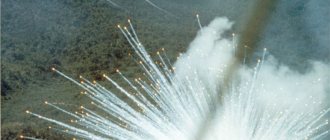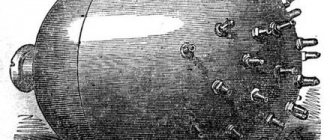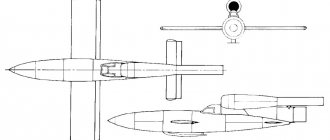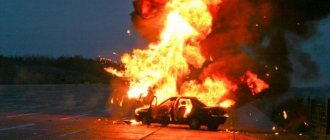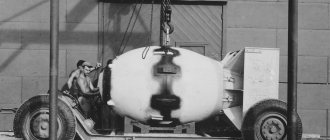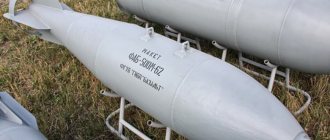Volumetric explosion ammunition
(
BOV
, also known as
thermobaric ammunition
,
vacuum bombs
,
volumetric detonating ammunition
(
ODB
), in English-speaking countries the term
fuel-air bomb
-
fuel-air bomb
) - a type of ammunition that uses the spraying of a flammable substance in the form of an aerosol and detonation the resulting gas cloud.
Large-caliber BOVs are comparable in power to ultra-small tactical nuclear weapons, but they do not have the radiation effect of destruction .
Term vacuum bomb
is based on the explosive pressure drop when burning out oxygen in the air, which is 150...170 mm Hg. (enough to damage small vessels and thin cavitary organs).] At the same time, the shock wave of thermobaric ammunition, due to the large volume of the mixture being detonated, actually has a more pronounced negative pressure half-wave than that of conventional explosives
.
Technology
The operating principle of the ODB is based on the detonation of a cloud of flammable aerosol. Due to the large size of the cloud (orders of magnitude larger than the size of charges with condensed explosive), the shock wave retains its destructive effect over a long distance. The explosion occurs in two stages
:
- at the command of a fuse, usually a non-contact one, a small charge of a conventional explosive is detonated (its task is to evenly distribute the flammable substance throughout the volume of the cloud);
- with a slight delay, the second charge (or several charges) is detonated, causing the detonation of the aerosol.
The ODB is used as fuel
:
- Ethylene oxide.
- Propylene oxide.
- Methyl and dimethyl acetylene.
- Butyl and propyl nitrite.
Currently, the efforts of engineers working on the creation of thermobaric ammunition are aimed at creating a technology for the formation of a more uniform cloud of air-fuel mixture and a more symmetrical detonation - that is, the conditions under which the maximum effect of the explosion is achieved
.
Thermobaric death
On February 1, 2000, immediately after the next test of a thermobaric bomb, Human Rights Watch, a CIA expert, described its effect as follows: “The direction of the volumetric explosion is unique and extremely life-threatening. First, people in the affected area are affected by high pressure of the burning mixture, and then by a vacuum, in fact a vacuum, tearing the lungs. All this is accompanied by severe burns, including internal ones, since many manage to inhale the fuel-oxidative premix.”
However, with the light hand of journalists, this weapon was called a vacuum bomb. Interestingly, in the 90s of the last century, some experts believed that people who died from a “vacuum bomb” seemed to be in space. They say that as a result of the explosion, oxygen instantly burned out, and for some time an absolute vacuum was formed. Thus, military expert Terry Garder from Jane magazine reported on the use of a “vacuum bomb” by Russian troops against Chechen militants in the area of the village of Semashko. His report said that those killed had no external injuries and died from ruptured lungs.
Story
In fact, a volumetric explosion is one of the first phenomena of this nature and scale with which man became acquainted. The first cases of volumetric explosions were noted even before our era in mills, where flour suspended in the air exploded. Later, similar cases were noted in factories where plant dust exploded, etc. Some of the most dangerous industries in this regard are sugar and flour mills.]]
On September 11, 2007, Russia tested the world's most powerful vacuum bomb (and the world's most powerful non-nuclear bomb), which was unofficially dubbed the "Father of All Bombs." Previously, the high-explosive bomb GBU-43/B MOAB “Mother of all bombs” made in the USA, tested in 2003, was considered the most powerful]]
.
Domestic gas explosion
The destruction caused by household gas explosions shown on television is simply amazing - people die, walls collapse, ceilings collapse. And it becomes interesting - how does this same household gas explode - and whether such an explosion is actually capable of causing such damage. And maybe it’s better then to just make “gas bombs” from gas cylinders and drop them, for example, on ISIS terrorists.
Go straight to the end of the article and find out:
Under what conditions can household gas explode?
How to protect yourself from a household gas explosion
An article about why a house exploded in Magnitogorsk in the article - Why can
multi-story building explode
Photos from the sites of recent domestic gas explosions:
Volgograd - the roof was torn off, almost eight floors collapsed.
Yaroslavl - the roof was also torn off, and again all five floors collapsed...
Added 01/01/2019 Another “gas explosion” this time on New Year’s Eve in the city of Magnitogorsk, people died under the rubble. (Creepy of course). The roof was torn off and the ceilings collapsed. Moreover, the explosion occurred early in the morning, when people were still sleeping - all 70 people apparently fell to death. (The network was worried that people were frozen under the rubble, because the temperature dropped to -25 degrees Celsius at night. But in the middle of the day, rescuers from the Ministry of Emergency Situations found an infant alive in the rubble. How did he not freeze? It turns out that the place of the rubble, rescuers from the Ministry of Emergency Situations, is all this time was heated with special heat guns, which enabled the child to survive. Maybe someone else managed to survive)
But thanks to the Internet, you can now easily see how various gases explode in real conditions - and watch explosions both in gas cylinders and in apartments, tanks, cars and even pipelines. Moreover, it turns out that a bunch of eccentrics go “out into nature” and explode household gas cylinders - which also provides a lot of materials for research.
A gas cylinder explodes with a rifle shot. (The gas cylinder is first set on fire so that there is an open fire, and then they shoot at it from a distance with a rifle. The explosion is quite large. Risky people, of course)
Propane tanks exploding in bonfires - people are experimenting and just having fun. (The meaning is very simple - people light a fire around the cylinder and wait for the cylinder to explode due to heating) Explosions everywhere are very serious and voluminous. Fire bombs just like that.
Welding, apparently, a gas pipe under pressure - it would seem that there are huge volumes of gas in the pipe - but meanwhile the pipe does not explode - the gas does not have time to create a sufficient explosive mixture with oxygen - it simply burns out and that’s all. (As you can see, a lot depends on where the gas explosion occurs (if in a closed room, everything is completely blown apart, if in an open space, nearby structures are not even damaged. This is an amazing feature of a gas explosion, it simply flows around without causing any harm to them at all. That is, we can say that a gas explosion is a volumetric explosion)
The explosion of a propane tank in a burning house - in the background - the fire cloud rises quite high - such a large explosion - despite the fact that apparently the gas is in the tank. That is, it turns out that the gas escapes through open space even during an explosion, without causing any damage.
An explosion of household gas in an apartment (or a gas cylinder - most likely with propane - filmed by a car video recorder - it is clear that the blast wave is of sufficient power - the fragments reach the car with such force that they damage the windshield.
An explosion of a gas cylinder in a garage - the explosion simply “falls out” a metal door and a brick wall. (In my opinion, the most striking confirmation of the destructive power of a gas explosion in confined spaces.
An explosion of a gas cylinder again in a private residential building - while the house remains standing in its place. Apparently because the gas has somewhere to go,
A propane explosion in a private residential building looks like a massive explosion, but the shock wave is very weak - the house is not blown to pieces, and the firefighters just stood there - they only ducked down a little. (But as I already noted, this doesn’t always happen. Sometimes a house or garage can simply be smashed to pieces)
The explosion of gas cylinders in a Gazelle car is also such a good “volumetric explosion” - but again, there is no shock wave.
The explosion of a railway tank with propane is a powerful volumetric explosion of gas; in slow motion you can see how either a car or a railway platform flies out of the explosion zone literally “like a sliver.”
You also come across some weirdos whose gas seems to explode on its own.
The volumetric explosion of a gas cylinder - and the man’s pants were only burned and there was no blast wave - he was simply doused with fire. (Even apparently, it was people who conducted an experiment - the effect of a volumetric explosion on a person)
The man decided to cut the gas cylinder by welding. But there was gas left there - the cylinder caught fire and set fire to the excavator. But it didn’t explode—the gas was again in the cylinder under pressure. The excavator was still able to burn due to the actions of this worker. Even the firefighters were unable to help.
An explosion of an oxygen cylinder—or rather, its ejection due to jet thrust. (Here a person simply, methodically hammers a gas cylinder, precisely to achieve the effect of jet thrust on the cylinder.)
But in fact, there is still ammunition that is used as an explosive - a gas cloud, and they are called volumetric explosion ammunition.
Volumetric explosion of a parachute bomb. The effect, as you can see, is simply devastating.
And another video of the destruction of houses from gas explosions that occurred abroad.
USA, gas explosion - a private house simply breaks into pieces, nothing remains of it at all. It was as if a bomb had exploded. “To pieces” - in the literal sense of the word.
Another gas explosion with almost complete destruction of a house in the British city of Sunderland also smashes the house “to pieces.”
Another foreign gas explosion - a tornado of fire simply breaks out the windows. (SNiPs specifically prescribe the size of windows so that a gas explosion would simply knock them out and that’s it, and no damage would be done to the house - in this video there is just such a case, if the windows had been smaller, the house would have been destroyed.) And such videos on the Internet too - complete.
Therefore, it is quite possible that under certain conditions, even household gas can acquire sufficient power that it will be capable of destroying a multi-story residential building. Usually, especially citizens of Russia begin to suspect the authorities of terrorist attacks, and shout about it at all corners, but in fact, everything apparently happens due to ordinary human sloppiness. although not that often. Apparently, a combination of several conditions is necessary for such an explosion and such destruction to take place. And so people living in multi-storey buildings are essentially hostages of such slobs. Fortunately, I repeat, such explosions are extremely rare. I personally have never seen anything like this in reality. The only time I saw an apartment burnt out completely in a building nearby was because its residents, relatively young people (unfortunately for them, had begun to drink alcohol frequently) set something on fire. And the neighbors later said that during the fire they had to pour water on the walls, so they became hot. And most importantly, another dysfunctional alcoholics live nearby in the same entrance, but no fires happen to them.
Under what conditions can household gas explode:
1. The room in which household gas accumulates must be sealed, then and only then when it detonates, excess pressure will be created sufficient to destroy structures
2. Gas concentration in the room is from 5 to 15% - at other concentrations the air-gas mixture will not be explosive
3. Source of open fire - to create detonation of this air-gas mixture.
As you can see, the requirements are quite serious, and also quite rarely combined in real conditions. Therefore, such explosions of air-gas mixtures of household gas are relatively rare. Creating the conditions for such an explosion is quite a difficult task, in fact.
How to protect yourself from a household gas explosion:
Here, too, everything is quite simple and also invented quite a long time ago, excluding all sorts of well-known methods of preventing gas equipment; the most effective means of protection against a gas explosion in a residential building is the installation of windows that swing outward, which during a gas explosion will simply be knocked out - that’s all. (Moreover, the installation of such windows is a prerequisite in gasified houses. (In Russia, in apartment buildings, ordinary plastic “Euro-windows” are installed, also secured so that, naturally, there can be no talk of knocking them out.
That is, the means of protection are quite simple, but at the same time not very feasible: either, for all residents of the house, keep the windows in the premises constantly open, or, at least for the entire entrance, install windows that swing outward.
Similar articles
- Veronika Skvortsova reported on the effectiveness of Mefloquine against coronavirus
- Why can
a multi-story building explode - All calendars
of the Ministry of Defense of the Russian Federation - Republishing articles - survey
(Republishing has begun!) - Why did riot police and police
tape up their helmets at rallies - An interesting idea - or “the first pancake is lumpy”
- Indirect cardiac massage and artificial respiration are a modern method.
- Russian Army Calendar 2020
Links
- Volumetric explosion ammunition
- Mixtures contained in Volume Explosion Ammunition
| Types of artillery ammunition | |
| Concrete | Armor-piercing high-explosive | Armor-piercing | Armor-piercing incendiary | Incendiary | Tracer | Impact core | Cumulative | Cumulative-fragmentation | Shrapnel | Buckshot | Shrapnel | High explosive | High Explosive | Thermobaric | Chemical | Nuclear | Propaganda | Smoke | Lighting | Sighting and target designating | Special Purpose Ammunition | Non-lethal ammunition |
Environmental and economic disaster
The protective equipment near the wellhead was quickly destroyed and the fire torch became higher. According to different versions, its height was from 70 to 120 m. 12 million cubic meters of gas burned in 24 hours. According to the most conservative estimates, 60 million rubles worth of fuel was burned per day. If you know that the fire lasted for almost three years, then billions of rubles worth of gas was destroyed.
Photo of a fire torch
The very high temperature did not allow us to come closer than a quarter of a kilometer to the fire site. They tried to cool the area near the fire torch by pouring water from fire carriages. This only caused the flames above the well to rise another 10 m.
The gas pressure increased and sudden breakthroughs of hydrogen sulfide formed on the surface. The situation was taking a terrible turn, any control was lost. Everything around was strewn with soot. What could have burned burned out long ago. There was no place for living things here. Sometimes migratory birds or flocks of insects, attracted by the light, rushed towards the colossal torch and burned before reaching the surface.
How did people work here, being at the mouth of real hell? The drillers were able to pull out the equipment and clear the area around the well.
Known Russian volume-detonating ammunition and high-yield ammunition
According to Human Rights Watch:
- ODAB-500PM, aerial bomb of volumetric detonating action.
- KAB-500Kr-OD, airborne volume-detonating bomb with television guidance.
- ODS-OD BLU container with 8 volumetric detonating cluster bombs.
- 300-mm 12-barrel MLRS 9A52-2 (Smerch), the warhead of a high-power rocket (based on a powder reagent).
- 220-mm 16-barrel MLRS 9P140 (Uragan), the warhead of a high-power rocket (based on a powder reagent).
- ATGM "Sturm", launched from a helicopter, the warhead has a volumetric detonating effect.
- ATGM "Attack", launched from a helicopter, the warhead has a volumetric detonating effect.
- 80-mm aircraft missile S-8D (S-8DM), the warhead of a volumetric detonating effect.
- Long-range anti-tank guided missile system "Kornet-E": the warhead of a thermobaric (volume-detonating) missile.
- RPO-A (Shmel) infantry flamethrower. The fatal impact and destruction inside the structure is reported to be 80 cubic meters. In open areas, the area of effective destruction is 50 square meters.
- AS-11 and AS-12, missile warheads. Most of the information is classified.
Sergey Minenko
Nuclear bomb explosion
The accident lasted more than two years; many extinguishing methods were used, but nothing helped. Nobody knew what to do. The last option was proposed - the explosion of a nuclear bomb. The idea was approved, a projectile was developed, and work on its creation was carried out at the highest possible speed.
A longitudinal borehole was made into which a nuclear charge was placed to a depth of 1.5 km. In the fall of 1966, an explosion was carried out, the force of which was 30 kt. For comparison, the explosion of a nuclear shell in Hiroshima had a force of 18 kt.
Everything worked out - not even 30 seconds had passed before the terrifying pillar of fire went out. The well was compressed by layers of rock. The decision was made successfully, and several more fires were subsequently extinguished in a similar manner.
In total, the gas fire at the Urta-Bulak field was extinguished for 1074 days.
Explosive character
The uranium nucleus contains 92 protons. Natural uranium is mainly a mixture of two isotopes: U238 (which has 146 neutrons in its nucleus) and U235 (143 neutrons), with only 0.7% of the latter in natural uranium. The chemical properties of isotopes are absolutely identical, therefore it is impossible to separate them by chemical methods, but the difference in masses (235 and 238 units) allows this to be done by physical methods: a mixture of uranium is converted into gas (uranium hexafluoride), and then pumped through countless porous partitions. Although the isotopes of uranium are indistinguishable either in appearance or chemically, they are separated by a chasm in the properties of their nuclear characters.
The fission process of U238 is a paid process: a neutron arriving from outside must bring with it energy - 1 MeV or more. And U235 is selfless: nothing is required from the incoming neutron for excitation and subsequent decay; its binding energy in the nucleus is quite sufficient.
Chain reaction When hit by neutrons, the uranium-235 nucleus easily splits, producing new neutrons. Under certain conditions, a chain reaction begins.
When a neutron hits a fission-capable nucleus, an unstable compound is formed, but very quickly (after 10−23−10−22 s) such a nucleus falls apart into two fragments that are unequal in mass and “instantly” (within 10−16−10− 14 c) emitting two or three new neutrons, so that over time the number of fissile nuclei can multiply (this reaction is called a chain reaction). This is only possible in U235, because greedy U238 does not want to share from its own neutrons, whose energy is an order of magnitude less than 1 MeV. The kinetic energy of fission product particles is many orders of magnitude higher than the energy released during any chemical reaction in which the composition of the nuclei does not change.
Metallic plutonium exists in six phases, the densities of which range from 14.7 to 19.8 kg/cm3. At temperatures below 119 degrees Celsius, there is a monoclinic alpha phase (19.8 kg/cm3), but such plutonium is very fragile, and in the cubic face-centered delta phase (15.9) it is plastic and well processed (it is this phase that they are trying to preserve using alloying additives). During detonation compression, no phase transitions can occur—plutonium is in a state of quasi-liquid. Phase transitions are dangerous during production: with large parts, even with a slight change in density, a critical state can be reached. Of course, this will happen without an explosion - the workpiece will simply heat up, but a discharge of nickel plating may occur (and plutonium is very toxic).
